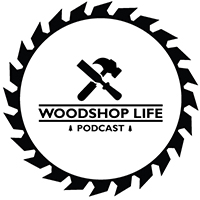This Episodes Questions:
Brians Questions:
I have a question on wood storage I have a smaller shop and lots of tools so wood storage space is tight. I purchase my wood based on what I have planned for the next 2-3 projects and try not to stock many extra boards. I store them on end leaning against an outside wall. I often clamp several boards together to help avoid bowing. So far no problems but I am fairly new to full time woodworking as I retired 2 years ago.
Do you see any problems with this method that I haven’t experienced yet? With the cost of hardwood lumber I don’t want to be surprised with wood that I cant use. Thanks Dean
I’m just finishing up building all the cabinetry for my Seattle home and decided to take on the interior doors as a new challenge. I’d like the doors to appear as if they’re made from 5-6 vertical wood boards, with a small 1/8” kerf between each board (I’ve attached an inspiration image). I know that a large glue-up of solid wood would expand and contract undesirably for a door, so here’s my current plan to keep things stable:
I’m planning to veneer 1 1/2” by 5 1/2” TimberStrand engineered studs with 1/8” shop-sawn veneers in a vacuum press, ending up with a 1 3/4” stile. Then, I’d edge glue the 5-6 stiles together, reinforcing each joint with Dominos. Once glued up, I’d add the 1/8” kerfs with a track saw.
My questions are as follows:
1. Would you recommend using the largest 14mm x 140mm Dominos between each stile, and if so, how many and at what spacing across each 8-foot section?
2. Do you have any tips for gluing the doors up flat?
3. Does this seem like a viable method to achieve a flat, stable door with the look I’m after, or is there another approach you’d suggest?
Thanks for your input and for all the time you put into creating such a great show! Best, Sam
I would like your thoughts on the depth/ratio you prefer for cabinet or bookcase dado’s for shelves – for example if using 3/4″ plywood for a cabinet, or 3/4″ hardwood a bookcase. It is my understanding that 1/4″ is a good depth overall. I am planning on building both some cabinets this fall, but my current project that I am preparing for is a hardwood Scandinavian bookcase. I am considering fixed shelves installed via dado. Each shelf will have an offset vertical shelf divider, also installed via dado. John Sanchez
Guys Questions:
A few years ago I refinished our oak dining table. It may be close to 100 years old. My mother used it in her youth, and I am now 61 years old. To refinish it, I used – sorry to say – MinWax – stain and water based satin Polycrylic. We use this table everyday for any meal we eat at home. Well, the finish has gotten gummy where I rest my arms on the table. Now I need to refinish it again.
I had recently applied Osmo Polyx-Oil hard oil wax on a guitar neck that I finished, and really like it. Would this be a good, durable finish for an oak dining table that sees daily use? And not gum up again?
Thanks, David Vespoint
I am contemplating a (non-epoxy) dining table build using some soft maple slabs I have acquired. I will mill the slabs into as wide of boards as I can and glue them up and get them surfaced so that my final dimensions will be about 84”x35”x2.5”. I want to add a fairly significant under bevel, leaving about 3/4” on the edge and cutting at a 16 degree (or 74 degree, depending on how you measure it) angle, so that the bevel ends about six inches from the edge on the bottom of the table. My question is: How the heck do I do that? I have a table saw, but I don’t think I’m lifting this whole tabletop and running it through my table saw (the blade isn’t long enough anyways). I thought about getting a track saw, but it turns out they use dinky little blades. Do I make an angled sled for my router? Do I use my 4” handheld power plane? Is there another solution I am not imagining? Thanks! Jon
I’m building a couple of nightstands for my daughter based on an image she gave me. She needs the diameter of the round top to be between 15 and 17 inches. The legs are 2 panels, one is 13 inches wide and one is 10 inches wide, the 10 inch wide panel will be cut at an angle and attached at 90 degrees to the 13 inch panel. I made a template with MDF, and the table works fine with the top width of 16 inches.
I’ll be using knotty alder and I can get it in 5″ 7″ 8″ and 10″ widths. My question is: when I get the boards to glue together to make the correct sized panels for cutting into the legs and top, should I use all the same widths of boards I buy, or can I vary the widths to use the wood most efficiently? It’s an aesthetic question more than an functional one. Do table makers use the same width of boards for the top and the base of tables? If you don’t, does it look odd?
If I could attach a photo this might make more sense. Thanks! Trish
